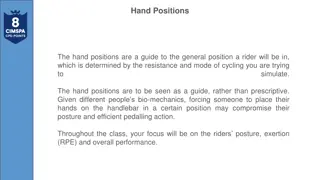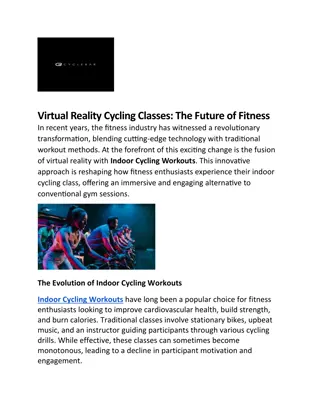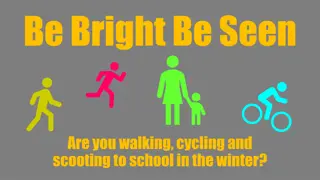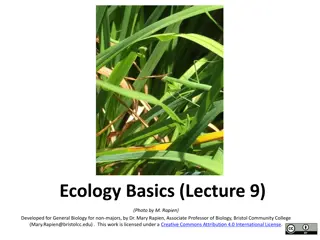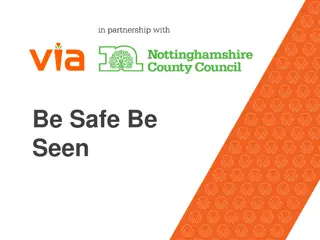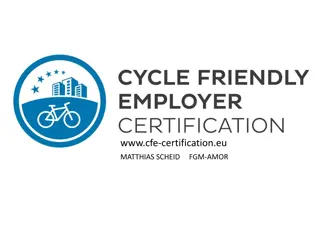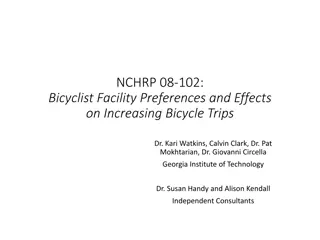Essential Guidelines for Safe and Effective Cycling
Learn about safety equipment, fundamental bike handling, road surface safety, and group riding techniques with a focus on safety and communication skills. Discover the importance of helmets, gloves, eye protection, brakes, and toe clips/straps for cyclists, as well as the principles of traffic safety and training rides to enhance fitness and road skills.
Download Presentation

Please find below an Image/Link to download the presentation.
The content on the website is provided AS IS for your information and personal use only. It may not be sold, licensed, or shared on other websites without obtaining consent from the author. Download presentation by click this link. If you encounter any issues during the download, it is possible that the publisher has removed the file from their server.
E N D
Presentation Transcript
Effective Cycling Information for this segment is based in part on the Effective Cycling book written by Mr. John Forester, and the Effective Cycling video Seidler Productions Inc. Pages 9-17
Student Performance Objectives List the five items of safety equipment that are a necessity for a cyclist. List and demonstrate the three fundamentals of bicycle handling. Discuss road surface safety and the appropriate steps to avoid road hazards. Cite the cyclist safety rule List the five principles of traffic safety.
Student Performance Objectives (cont.) List the safety factors to consider when cycling at night. List the safety factors to take when cycling in the rain. Discuss the techniques used in hill ascents and descents. Discuss cycling in groups and describe the responsibilities of the group leader.
5 Items of Safety Equipment Helmet Gloves Eye Protection Brakes Toe Clips/Straps, or Clipless Systems
Training Rides Increase fitness Sharpen road skills Teaches communication skills To riders and other roadway users Verbally Hand signals
Group Riding Lead rider(s) usually calls the route and formations Be predictable to the other riders and roadway users No jack rabbit starts Communication Call out and point to obstacles that may cause a flat or cause someone to go down Everyone else repeats the call out so entire group knows of the hazard
Group Riding Pace lines are singles and doubles formations Stay close to the rider in front of you Do not overlap tires
Group Riding During the class we will ride in singles or doubles (aka ones and twos)
Group Riding At times we will need to switch from ones to twos and twos to ones Shoulder checks: Must be preformed before switching. Lets you know if its clear to move. Keeps you informed of your surroundings.
Group Riding Take the Lane A lane change Verbal AND Hand signal Why? Shoulder check Verbalize clear From back, to front
Group Riding New Lead Why? Verbalize Shoulder check From front, to back
Group Riding Other call outs you may here: Slowing Move Wait Clear Car back Downshift Drink
Group Riding Braking Emergency braking Both front and rear brakes Pedals at 3 & 9 Weight over rear axel Instant Turns A way to avoid an obstacle quickly
Road Surface Safety Gravel Avoid, do not turn sharply Drains and grates Smooth and slippery Grates can cause falls depending on angle with your tire Road turtles (lane dividers) Painted areas
Road Surface Safety Railroad tracks Cross at 90 degrees or as close to as possible Maintain a signal lane Can be done in ones or twos (communication)
Traffic Safety Cyclists Fare Best When They Act and Are Treated as Drivers of Vehicles . John Forester
5 Principles of Traffic Safety 1. Drive on the right side of the road. 2. Yield to cross traffic. 3. Lane Positioning 4. Yield when changing lanes. 5. Speed positioning.
5 Principles of Traffic Safety 1. Drive on the right side of the road. Exceptions? Country roads One way roads
5 Principles of Traffic Safety 2. Yield to cross traffic. Who has right of way Pedestrians
5 Principles of Traffic Safety 3. Lane Positioning Rule of thirds Right turn, right most lane Lane choice Destination positioning Multi destination lanes Merging with, and merging traffic
5 Principles of Traffic Safety 4. Yield when changing lanes Shoulder check Signaling How, and when
5 Principles of Traffic Safety 5. Speed positioning Allow for conditions If you are as fast as vehicles Take the lane
Riding In The Rain Keep dry Gortex Protect against cold Layer Be visible Bright clothing Avoid metal, paint, lane markers, lane position B , leaves, puddles.
Riding at Night Great time to RIDE! Can be dangerous because of limited vision 43% of all bicycle deaths occur between 8 PM & 8AM Be Seen Lights Reflectors Reflective gear
Hills Stay to the right Single file when ascending Fast as a car take the lane Equalize heat in rims when descending Lean into turns Too much speed, slide out rather than leaving the road
Summary These effective cycling techniques are essential for safety and confidence while cycling on or off road. The more you cycle and practice these skills, the less likely you will be involved in a mishap. Cyclists Fare Best When They Act and Are Treated as Drivers of Vehicles .
Student Performance Objectives - Review List the five items of safety equipment that are a necessity for a cyclist. List and demonstrate the three fundamentals of bicycle handling. Discuss road surface safety and the appropriate steps to avoid road hazards. Cite the cyclist safety rule List the five principles of traffic safety
Student Performance Objectives - Review (cont.) List the safety factors to consider when cycling at night. List the safety factors to take when cycling in the rain. Discuss the techniques used in hill ascents and descents. Discuss cycling in groups and describe the responsibilities of the group leader.

 undefined
undefined


 undefined
undefined




